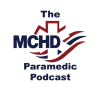In this episode, MCHD Medical Directors Dr. Robert Dickson and Dr. Casey Patrick tackle some of the most recent developments surrounding the COVID-19 pandemic.
Since our last COVID discussion, there have been several new promising treatment options.
- Steroids. Steroids have been tried for virtually every critical illness possible with often disappointing or even harmful results. Shockingly, The RECOVERY trial demonstrated a significant mortality benefit when treating intubated and oxygen requiring COVID-19 patients with daily dexamethasone. This study was very well done and likely represents standard of care at this point.
- Remdesivir. Remdesivir is an anti-viral originally developed for Hepatitis C and then tried in Ebola, both of which were unsuccessful. However, a recent international New England Journal study demonstrated that the addition of remdesivir decreased COVID-19 hospital length of stay from 15 days to 11 days. We’d love to see a larger study with a mortality centered endpoint, but, shaving 4 days off every COVID-19 hospitalization would help to ease overall pandemic system stress.
- Patient positioning. Pharmacologic treatment options aren’t the only promising option for COVID-19 patients. Many researchers are investigating the benefits of placing the silent hypoxics into the prone position. This helps to recruit the richly perfused, dense alveoli of the dorsal lung regions. Small pilot studies have shown this to be feasible and effective at raising oxygen saturation levels in the ED and ICU settings. Until we get some evidence of mortality benefit though, this is likely too logistically complex to attempt in the EMS setting … stay tuned.
Return to work guidance
Pivoting from treatment options, the discussion then delves into the recent CDC healthcare worker return to work recommendation changes. The trend is moving to a symptom-based protocol as opposed to testing based. Many COVID-19 patients who are entirely well and no longer contagious can continue to shed inactive viral RNA particles which can cause their PCR tests to be positive for prolonged periods. The CDC now states that healthcare workers can return to work if symptoms are improving/resolved for 24 hours.
MCHD has elected to maintain a slightly more cautious approach and allow return to work when symptoms have resolved for 72 hours. Obviously, your local staffing needs and infection rates will impact this decision. The best option is to prevent employee infection in the first place, right? PPE fatigue is real, but we must maintain vigilance even in the Texas summer heat.
Is there evidence for gowns preventing COVID-19 transmission? The unfortunate answer is that the gown research is weak and centered around exposure-based simulation studies. An EMS-based randomized trial sure would be nice, but in the end, we must operate with an abundance of caution.
Bizarre COVID-19 clinical complications
The episode closes with some of the bizarre clinical complications associated with COVID-19. This virus has shown itself to be markedly thrombogenic. Infected patients suffer both arterial and venous thrombotic events. This can include AMI, DVT, PE, CVA and even limb ischemia. Up to 25% of hospitalized and 50% of COVID-19 ICU patients suffer some form of thrombosis. All levels of emergency providers must keep their antennae up for a constellation of viral symptoms combined with clot. Simple, right?
Initially, it was thought that children were spared from COVID-19, but accumulating evidence is showing that this just isn’t the case. Multisystem Inflammatory Syndrome in Children (MIS-C) is becoming more recognized and continues to complicate this disease management. MIS-C is an inflammatory febrile condition that occurs several weeks post-COVID in pediatric patients. Be alert for fever, rash and multi-organ involvement in school aged children. Approximately 50% of MIS-C patients present in cardiogenic shock. Beware of bombing these patients with fluids and be ready to consider vasopressors.
At the conclusion of this episode, you’ll be up to date on all things COVID-19 … for now.
Listen next: How to safely manage COVID-19 respiratory failure patients



